Solving Problems with Sinusoidal Waves and Vector Functions - EE
VerifiedAdded on 2023/01/12
|16
|1980
|88
Homework Assignment
AI Summary
This assignment provides a comprehensive solution to problems involving sinusoidal waves and vector functions, crucial concepts in electrical engineering. The solution covers definitions of amplitude, periodic time, frequency, and phase shift, along with calculations for current in a circuit. It includes diagrams and calculations for force, moment, compound angle identities, and differentiation and integration problems. The assignment also explores the rate of change of voltage and particle speed, and it delves into the concept of charge and discharge in a circuit. Finally, the assignment determines maxima and minima of functions using calculus, offering a complete and practical guide to these fundamental engineering principles.
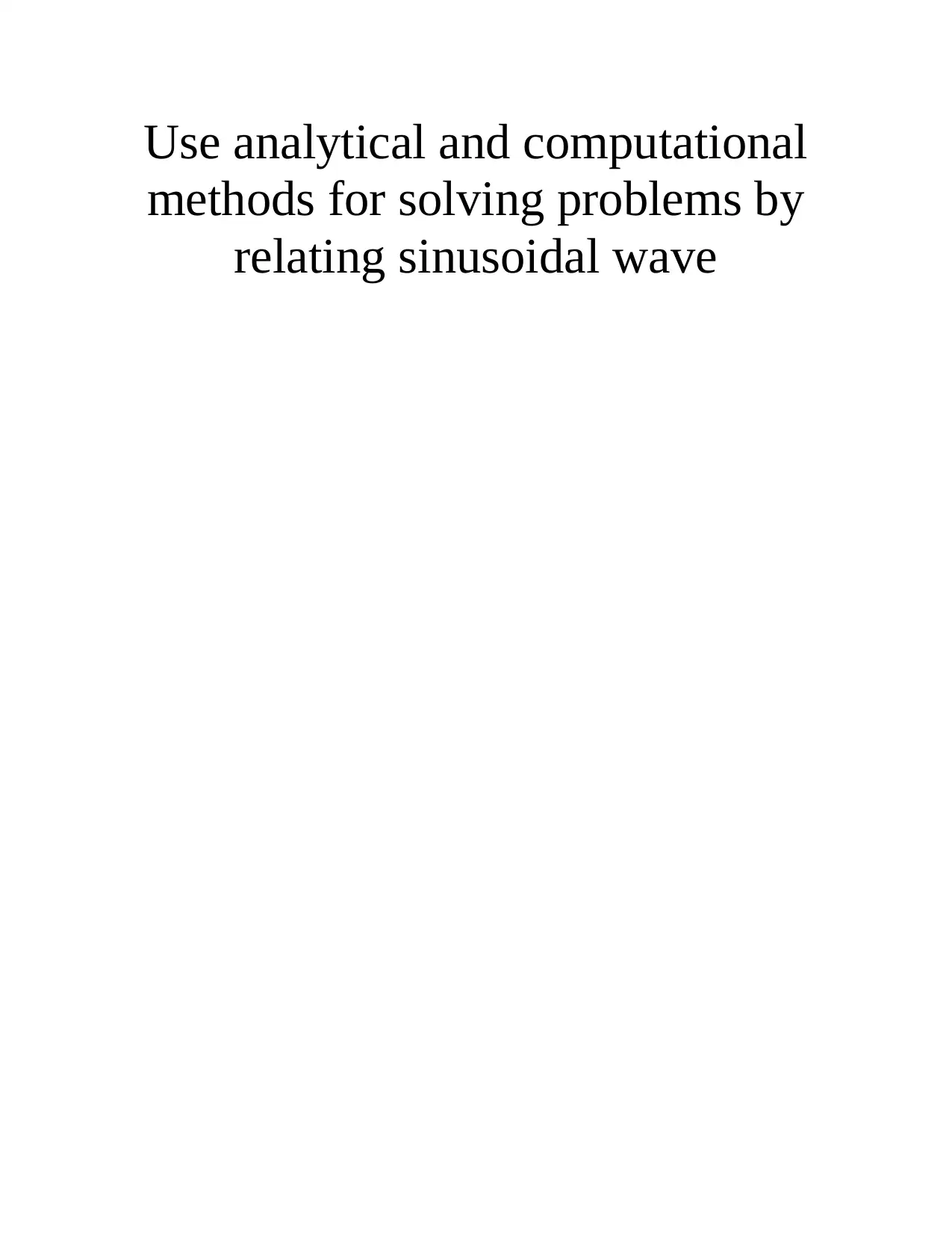
Use analytical and computational
methods for solving problems by
relating sinusoidal wave
methods for solving problems by
relating sinusoidal wave
Paraphrase This Document
Need a fresh take? Get an instant paraphrase of this document with our AI Paraphraser

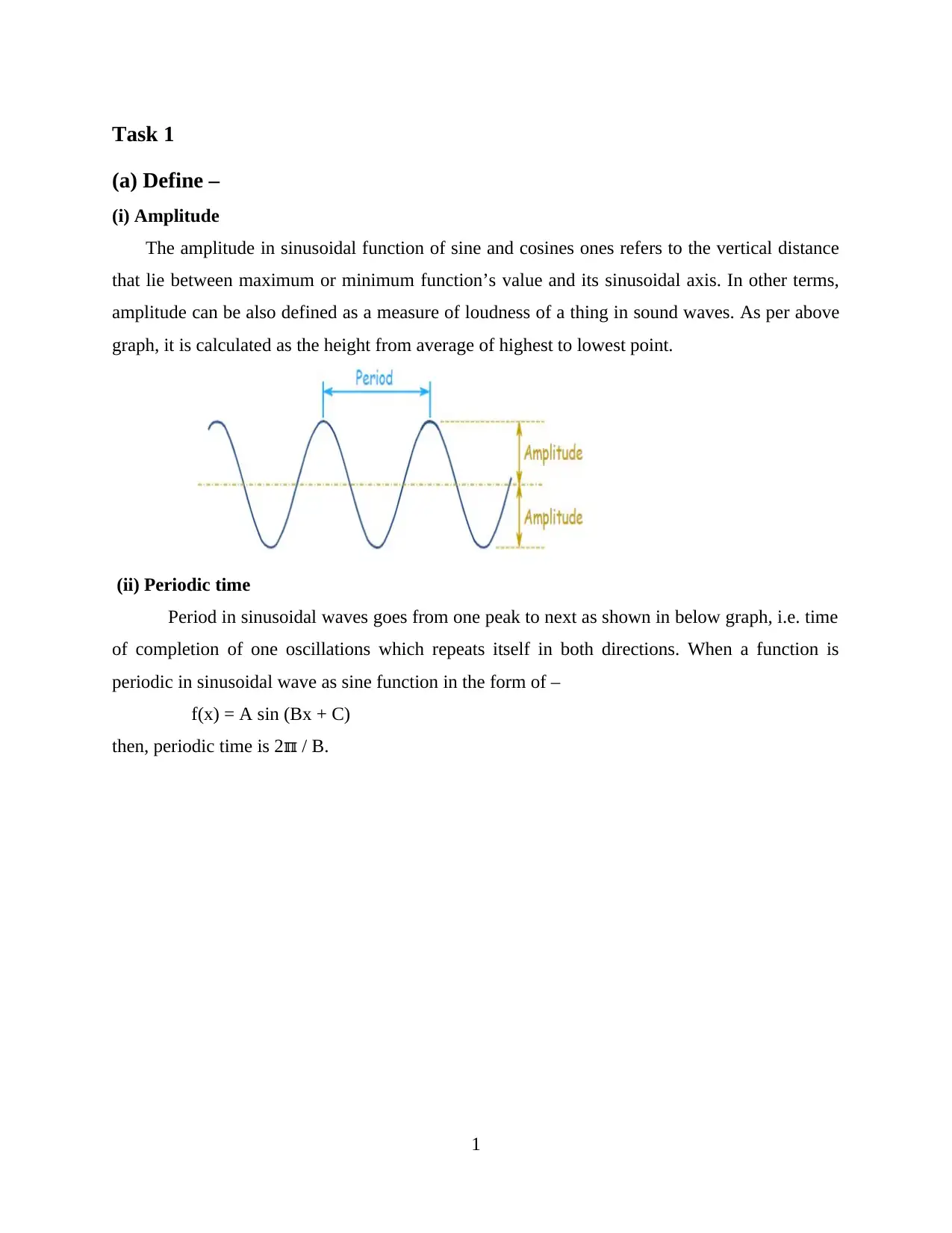
Task 1
(a) Define –
(i) Amplitude
The amplitude in sinusoidal function of sine and cosines ones refers to the vertical distance
that lie between maximum or minimum function’s value and its sinusoidal axis. In other terms,
amplitude can be also defined as a measure of loudness of a thing in sound waves. As per above
graph, it is calculated as the height from average of highest to lowest point.
(ii) Periodic time
Period in sinusoidal waves goes from one peak to next as shown in below graph, i.e. time
of completion of one oscillations which repeats itself in both directions. When a function is
periodic in sinusoidal wave as sine function in the form of –
f(x) = A sin (Bx + C)
then, periodic time is 2 / B.ℼ
1
(a) Define –
(i) Amplitude
The amplitude in sinusoidal function of sine and cosines ones refers to the vertical distance
that lie between maximum or minimum function’s value and its sinusoidal axis. In other terms,
amplitude can be also defined as a measure of loudness of a thing in sound waves. As per above
graph, it is calculated as the height from average of highest to lowest point.
(ii) Periodic time
Period in sinusoidal waves goes from one peak to next as shown in below graph, i.e. time
of completion of one oscillations which repeats itself in both directions. When a function is
periodic in sinusoidal wave as sine function in the form of –
f(x) = A sin (Bx + C)
then, periodic time is 2 / B.ℼ
1
⊘ This is a preview!⊘
Do you want full access?
Subscribe today to unlock all pages.

Trusted by 1+ million students worldwide
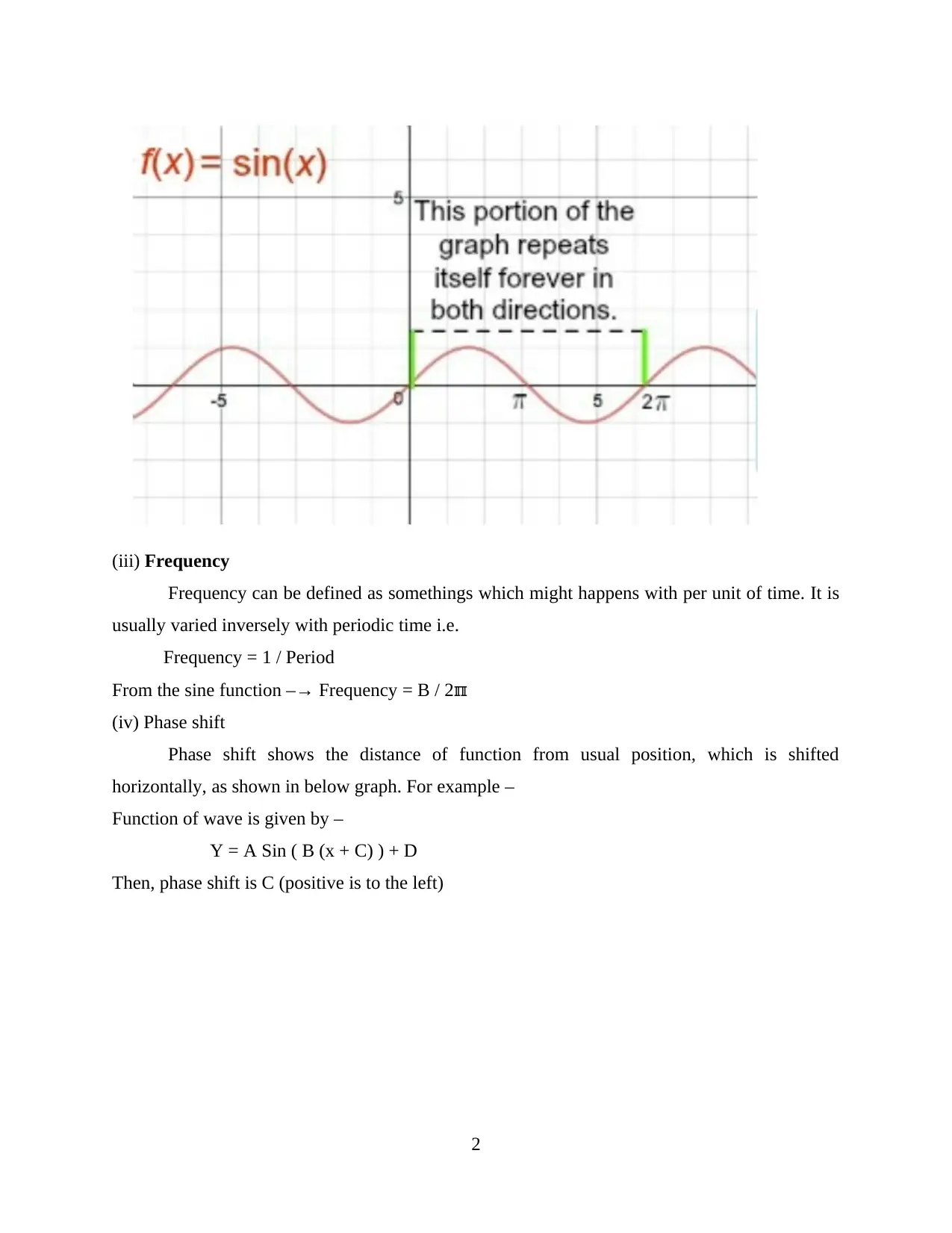
(iii) Frequency
Frequency can be defined as somethings which might happens with per unit of time. It is
usually varied inversely with periodic time i.e.
Frequency = 1 / Period
From the sine function –→ Frequency = B / 2ℼ
(iv) Phase shift
Phase shift shows the distance of function from usual position, which is shifted
horizontally, as shown in below graph. For example –
Function of wave is given by –
Y = A Sin ( B (x + C) ) + D
Then, phase shift is C (positive is to the left)
2
Frequency can be defined as somethings which might happens with per unit of time. It is
usually varied inversely with periodic time i.e.
Frequency = 1 / Period
From the sine function –→ Frequency = B / 2ℼ
(iv) Phase shift
Phase shift shows the distance of function from usual position, which is shifted
horizontally, as shown in below graph. For example –
Function of wave is given by –
Y = A Sin ( B (x + C) ) + D
Then, phase shift is C (positive is to the left)
2
Paraphrase This Document
Need a fresh take? Get an instant paraphrase of this document with our AI Paraphraser
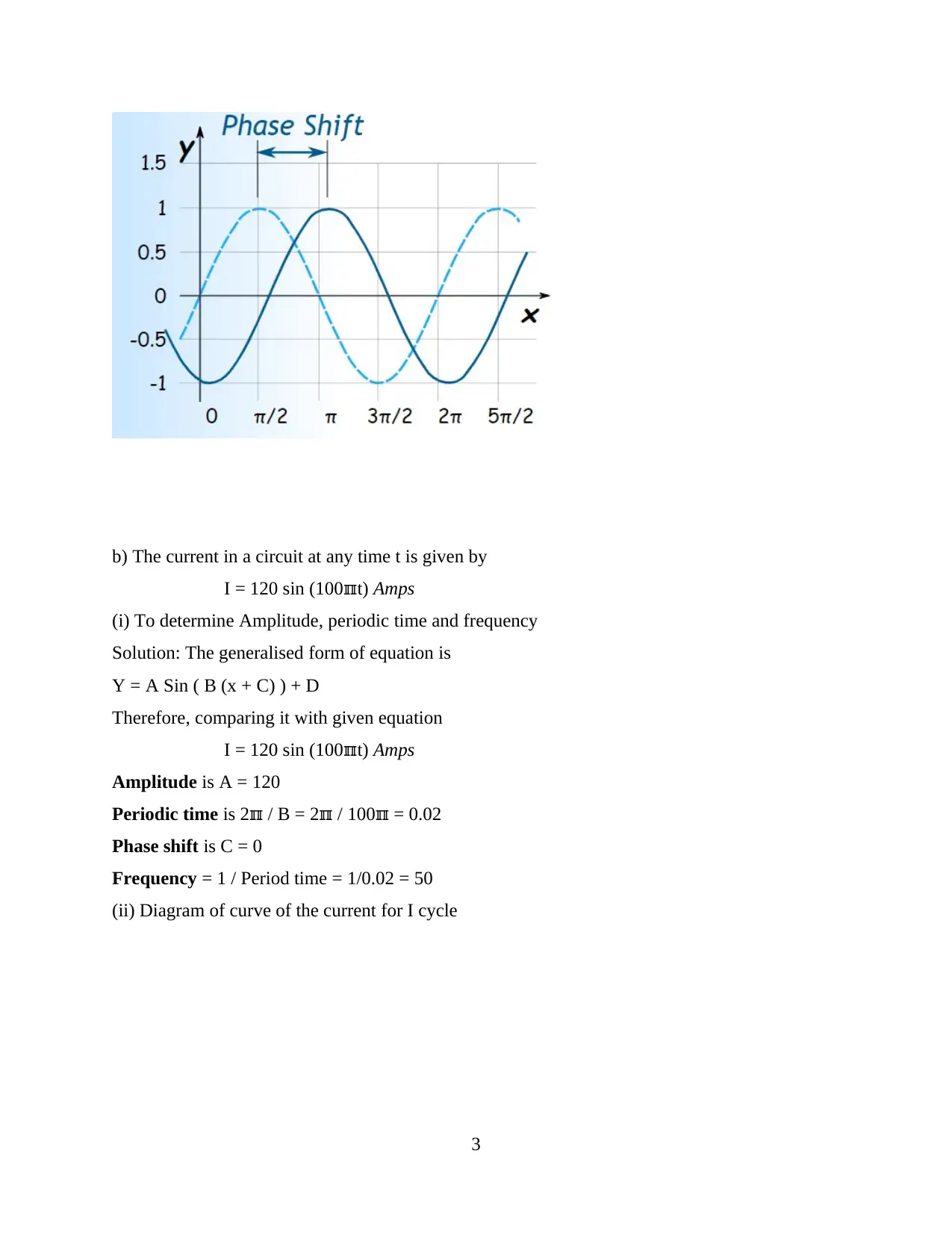
b) The current in a circuit at any time t is given by
I = 120 sin (100ℼt) Amps
(i) To determine Amplitude, periodic time and frequency
Solution: The generalised form of equation is
Y = A Sin ( B (x + C) ) + D
Therefore, comparing it with given equation
I = 120 sin (100ℼt) Amps
Amplitude is A = 120
Periodic time is 2 / B = 2 / 100 = 0.02ℼ ℼ ℼ
Phase shift is C = 0
Frequency = 1 / Period time = 1/0.02 = 50
(ii) Diagram of curve of the current for I cycle
3
I = 120 sin (100ℼt) Amps
(i) To determine Amplitude, periodic time and frequency
Solution: The generalised form of equation is
Y = A Sin ( B (x + C) ) + D
Therefore, comparing it with given equation
I = 120 sin (100ℼt) Amps
Amplitude is A = 120
Periodic time is 2 / B = 2 / 100 = 0.02ℼ ℼ ℼ
Phase shift is C = 0
Frequency = 1 / Period time = 1/0.02 = 50
(ii) Diagram of curve of the current for I cycle
3
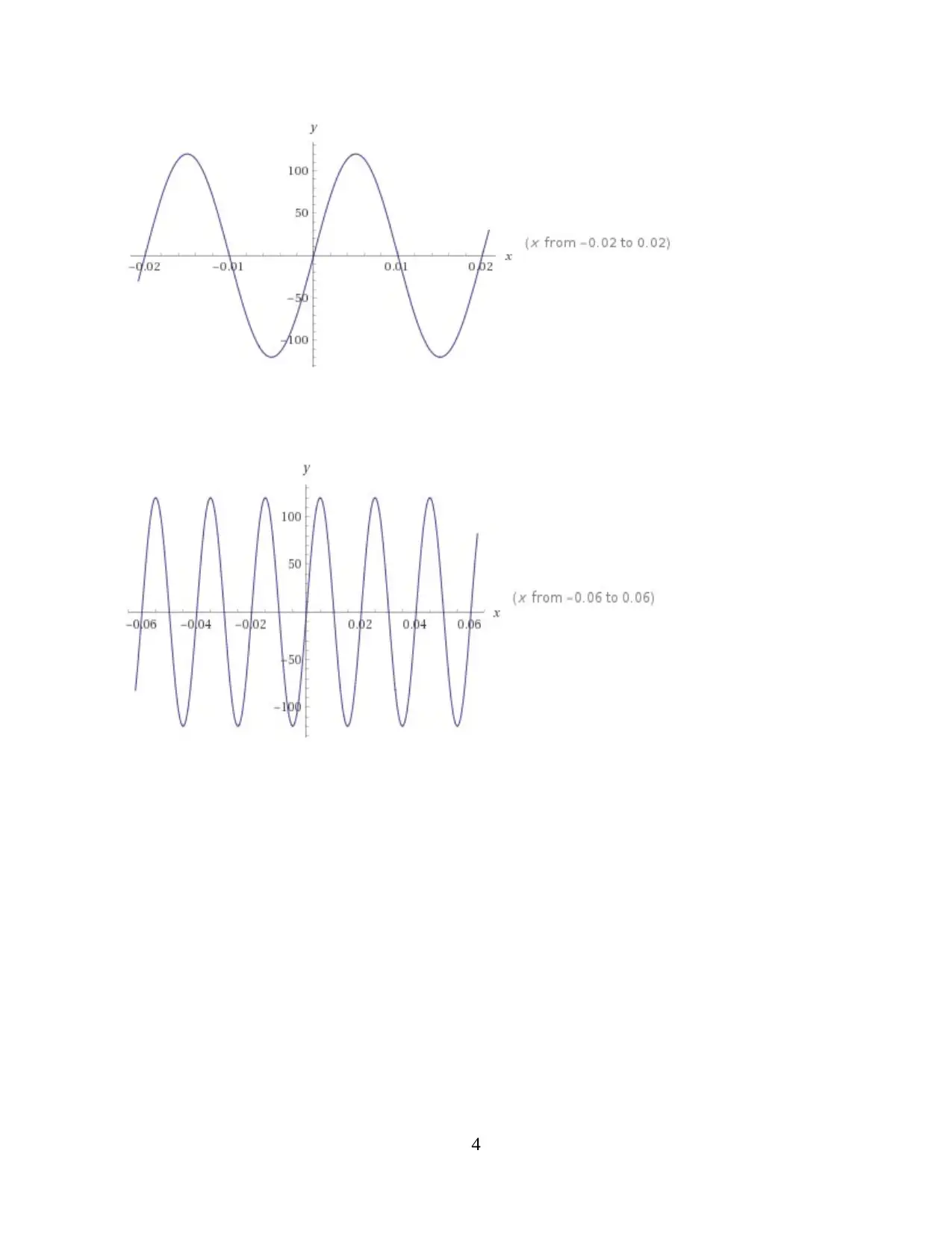
4
⊘ This is a preview!⊘
Do you want full access?
Subscribe today to unlock all pages.

Trusted by 1+ million students worldwide
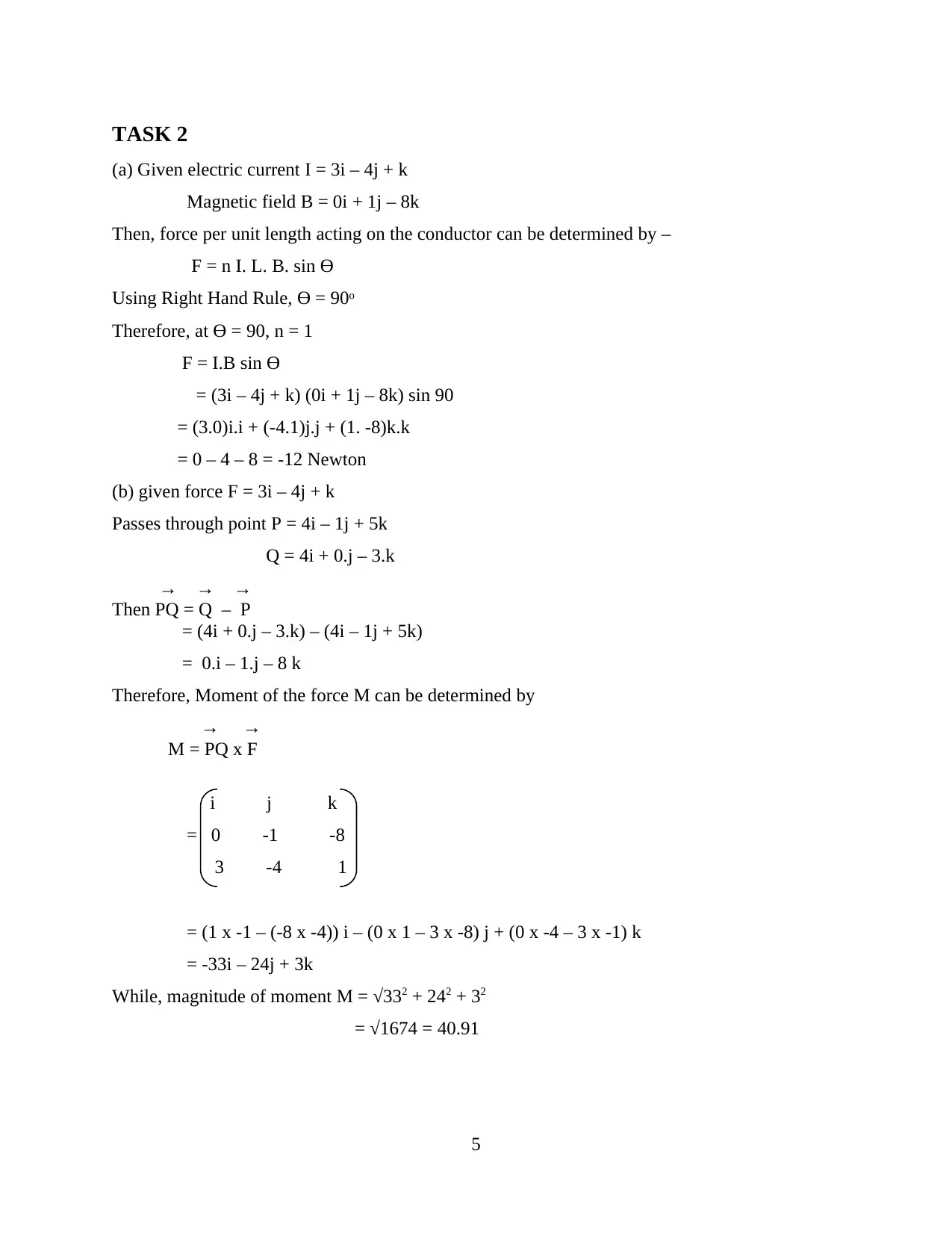
TASK 2
(a) Given electric current I = 3i – 4j + k
Magnetic field B = 0i + 1j – 8k
Then, force per unit length acting on the conductor can be determined by –
F = n I. L. B. sin Ө
Using Right Hand Rule, Ө = 90ᵒ
Therefore, at Ө = 90, n = 1
F = I.B sin Ө
= (3i – 4j + k) (0i + 1j – 8k) sin 90
= (3.0)i.i + (-4.1)j.j + (1. -8)k.k
= 0 – 4 – 8 = -12 Newton
(b) given force F = 3i – 4j + k
Passes through point P = 4i – 1j + 5k
Q = 4i + 0.j – 3.k
→ → →
Then PQ = Q – P
= (4i + 0.j – 3.k) – (4i – 1j + 5k)
= 0.i – 1.j – 8 k
Therefore, Moment of the force M can be determined by
→ →
M = PQ x F
i j k
= 0 -1 -8
3 -4 1
= (1 x -1 – (-8 x -4)) i – (0 x 1 – 3 x -8) j + (0 x -4 – 3 x -1) k
= -33i – 24j + 3k
While, magnitude of moment M = √332 + 242 + 32
= √1674 = 40.91
5
(a) Given electric current I = 3i – 4j + k
Magnetic field B = 0i + 1j – 8k
Then, force per unit length acting on the conductor can be determined by –
F = n I. L. B. sin Ө
Using Right Hand Rule, Ө = 90ᵒ
Therefore, at Ө = 90, n = 1
F = I.B sin Ө
= (3i – 4j + k) (0i + 1j – 8k) sin 90
= (3.0)i.i + (-4.1)j.j + (1. -8)k.k
= 0 – 4 – 8 = -12 Newton
(b) given force F = 3i – 4j + k
Passes through point P = 4i – 1j + 5k
Q = 4i + 0.j – 3.k
→ → →
Then PQ = Q – P
= (4i + 0.j – 3.k) – (4i – 1j + 5k)
= 0.i – 1.j – 8 k
Therefore, Moment of the force M can be determined by
→ →
M = PQ x F
i j k
= 0 -1 -8
3 -4 1
= (1 x -1 – (-8 x -4)) i – (0 x 1 – 3 x -8) j + (0 x -4 – 3 x -1) k
= -33i – 24j + 3k
While, magnitude of moment M = √332 + 242 + 32
= √1674 = 40.91
5
Paraphrase This Document
Need a fresh take? Get an instant paraphrase of this document with our AI Paraphraser
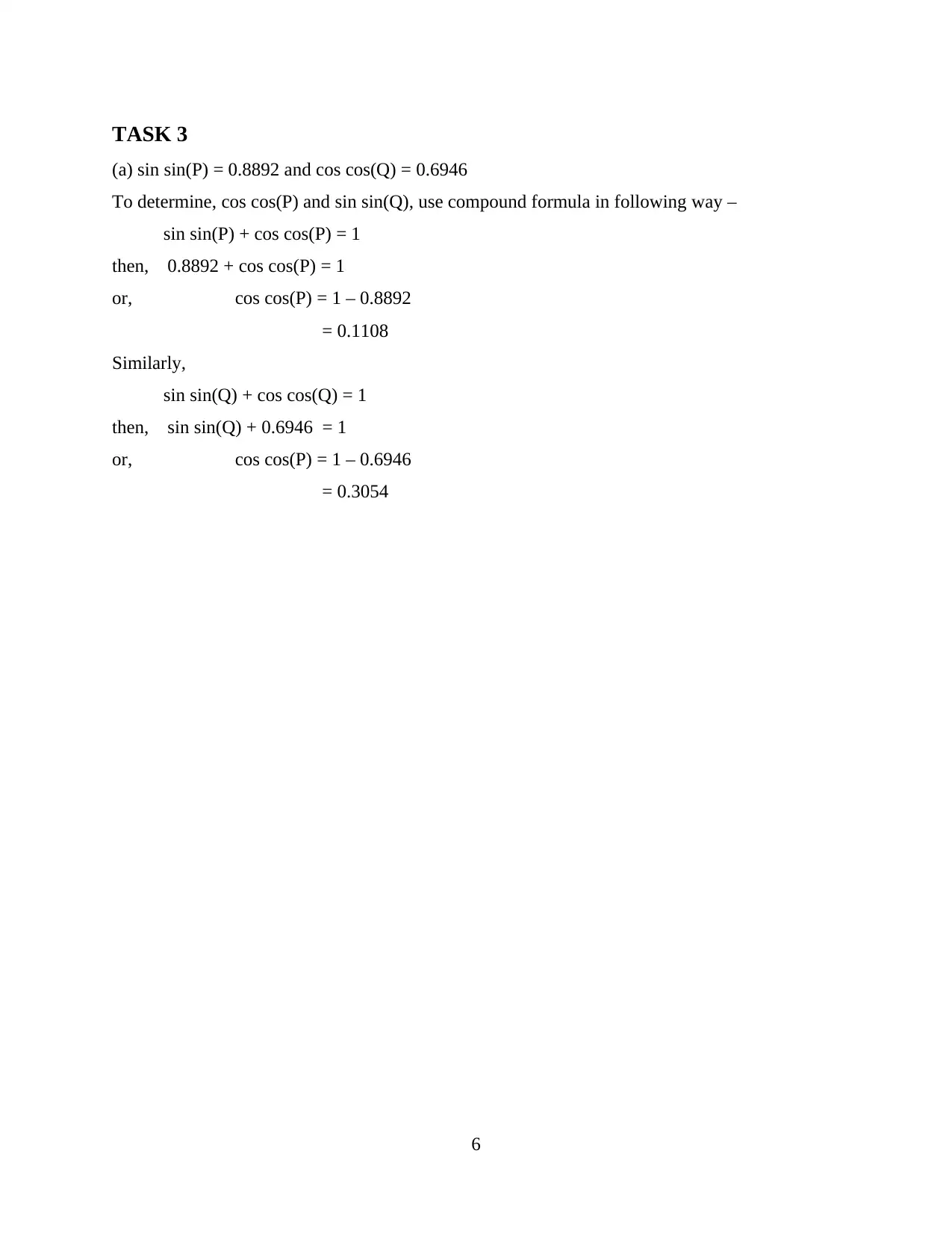
TASK 3
(a) sin sin(P) = 0.8892 and cos cos(Q) = 0.6946
To determine, cos cos(P) and sin sin(Q), use compound formula in following way –
sin sin(P) + cos cos(P) = 1
then, 0.8892 + cos cos(P) = 1
or, cos cos(P) = 1 – 0.8892
= 0.1108
Similarly,
sin sin(Q) + cos cos(Q) = 1
then, sin sin(Q) + 0.6946 = 1
or, cos cos(P) = 1 – 0.6946
= 0.3054
6
(a) sin sin(P) = 0.8892 and cos cos(Q) = 0.6946
To determine, cos cos(P) and sin sin(Q), use compound formula in following way –
sin sin(P) + cos cos(P) = 1
then, 0.8892 + cos cos(P) = 1
or, cos cos(P) = 1 – 0.8892
= 0.1108
Similarly,
sin sin(Q) + cos cos(Q) = 1
then, sin sin(Q) + 0.6946 = 1
or, cos cos(P) = 1 – 0.6946
= 0.3054
6
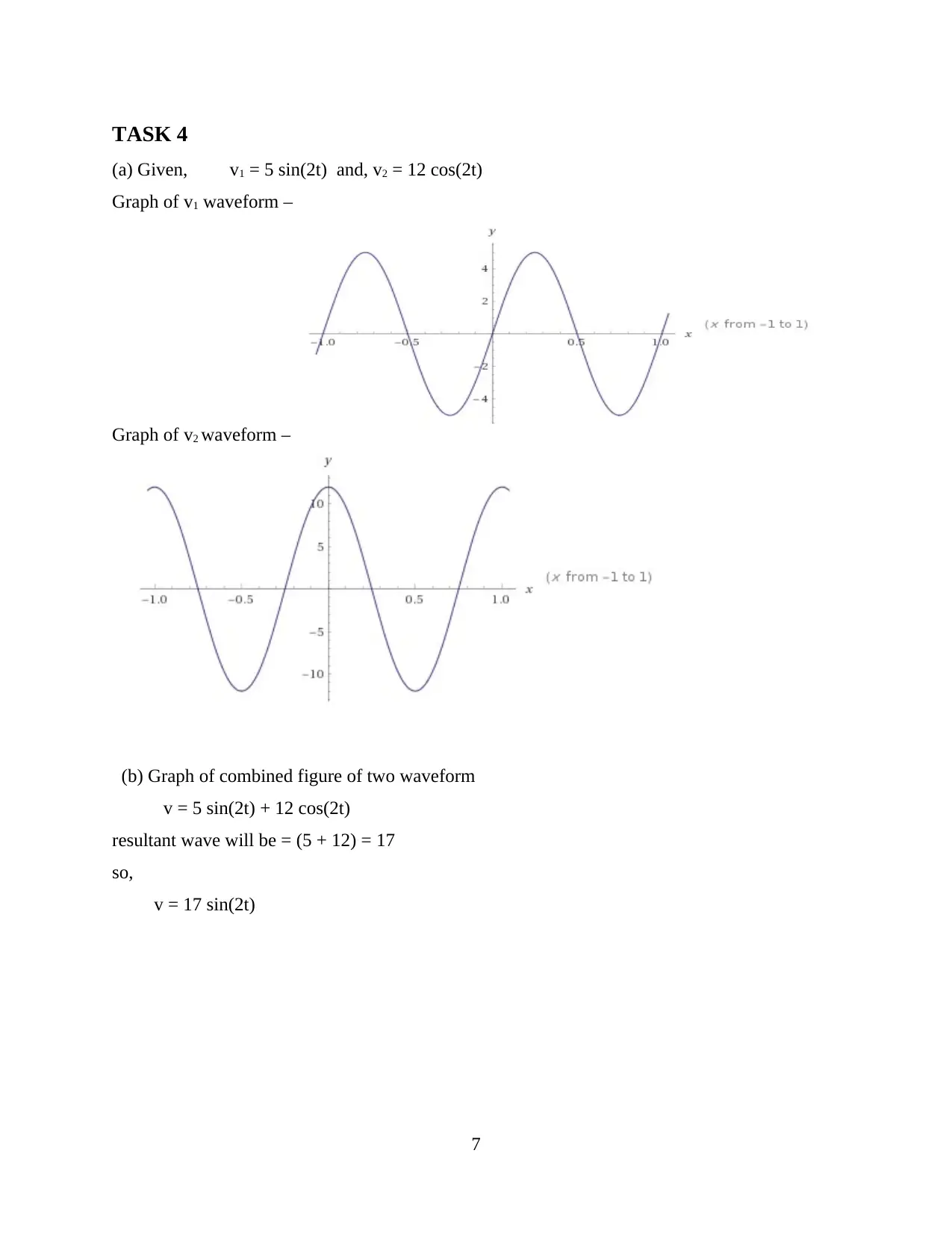
TASK 4
(a) Given, v1 = 5 sin(2t) and, v2 = 12 cos(2t)
Graph of v1 waveform –
Graph of v2 waveform –
(b) Graph of combined figure of two waveform
v = 5 sin(2t) + 12 cos(2t)
resultant wave will be = (5 + 12) = 17
so,
v = 17 sin(2t)
7
(a) Given, v1 = 5 sin(2t) and, v2 = 12 cos(2t)
Graph of v1 waveform –
Graph of v2 waveform –
(b) Graph of combined figure of two waveform
v = 5 sin(2t) + 12 cos(2t)
resultant wave will be = (5 + 12) = 17
so,
v = 17 sin(2t)
7
⊘ This is a preview!⊘
Do you want full access?
Subscribe today to unlock all pages.

Trusted by 1+ million students worldwide
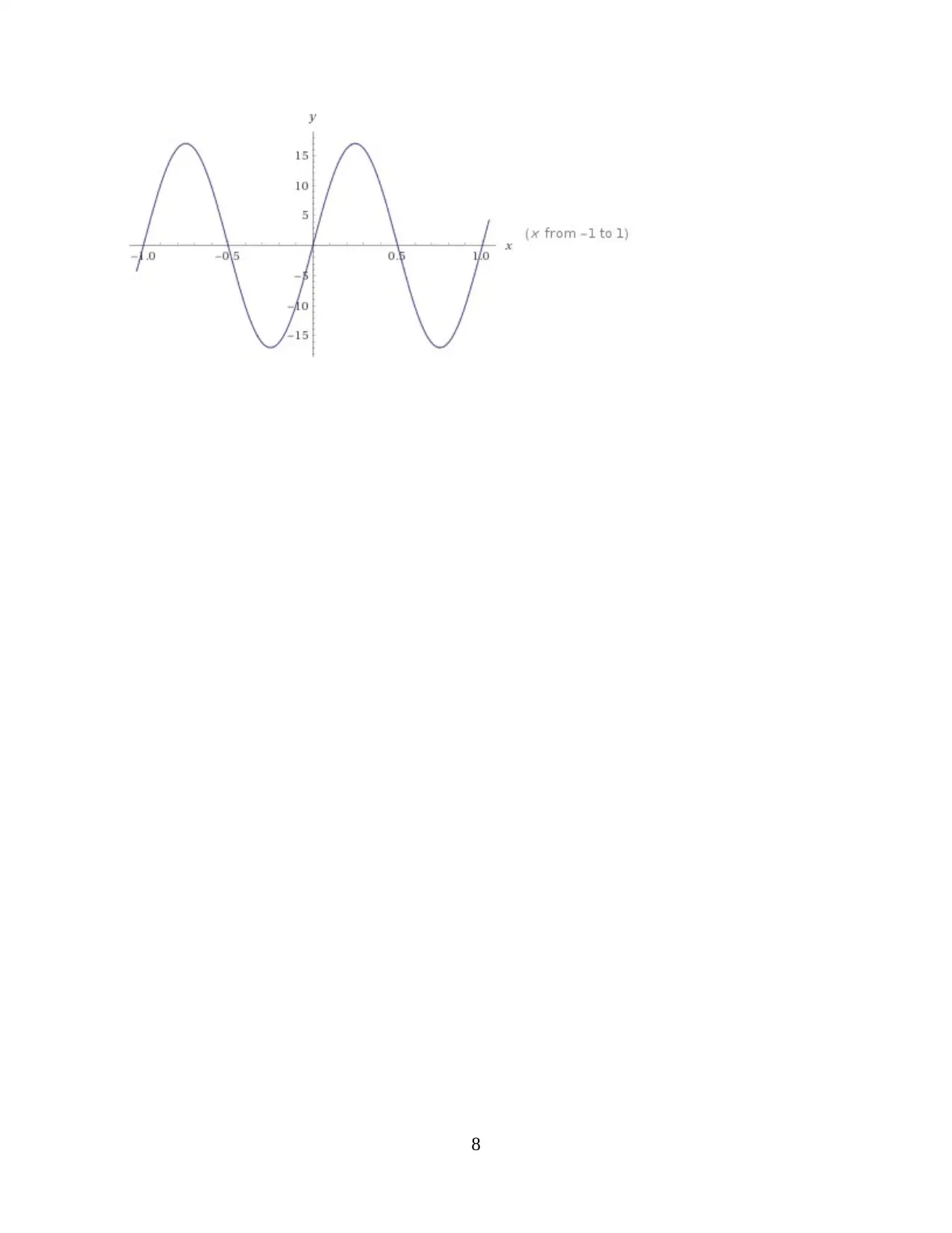
8
Paraphrase This Document
Need a fresh take? Get an instant paraphrase of this document with our AI Paraphraser
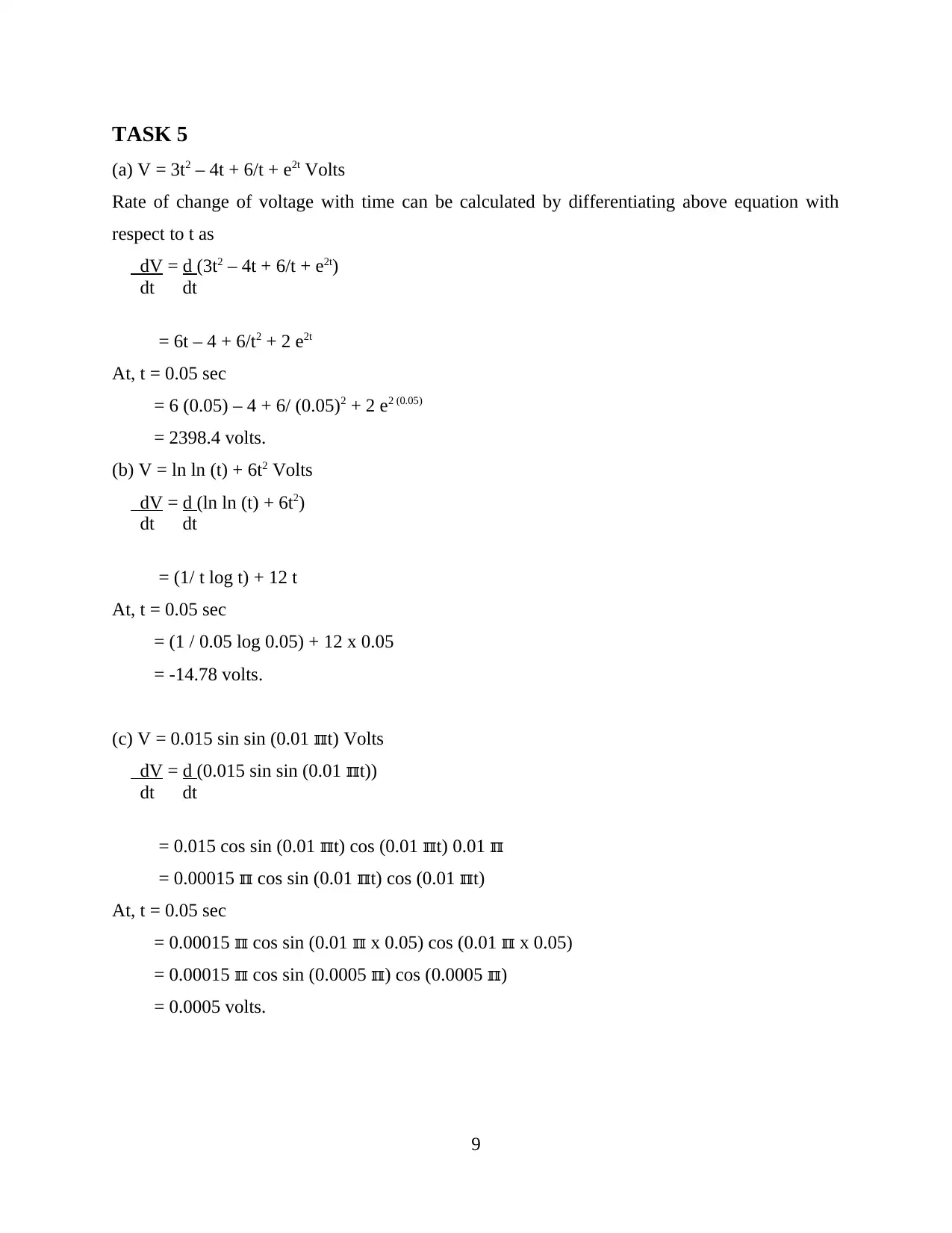
TASK 5
(a) V = 3t2 – 4t + 6/t + e2t Volts
Rate of change of voltage with time can be calculated by differentiating above equation with
respect to t as
dV = d (3t2 – 4t + 6/t + e2t)
dt dt
= 6t – 4 + 6/t2 + 2 e2t
At, t = 0.05 sec
= 6 (0.05) – 4 + 6/ (0.05)2 + 2 e2 (0.05)
= 2398.4 volts.
(b) V = ln ln (t) + 6t2 Volts
dV = d (ln ln (t) + 6t2)
dt dt
= (1/ t log t) + 12 t
At, t = 0.05 sec
= (1 / 0.05 log 0.05) + 12 x 0.05
= -14.78 volts.
(c) V = 0.015 sin sin (0.01 t) Voltsℼ
dV = d (0.015 sin sin (0.01 t))ℼ
dt dt
= 0.015 cos sin (0.01 t) cos (0.01 t) 0.01ℼ ℼ ℼ
= 0.00015 cos sin (0.01 t) cos (0.01 t)ℼ ℼ ℼ
At, t = 0.05 sec
= 0.00015 cos sin (0.01 x 0.05) cos (0.01 x 0.05)ℼ ℼ ℼ
= 0.00015 cos sin (0.0005 ) cos (0.0005 )ℼ ℼ ℼ
= 0.0005 volts.
9
(a) V = 3t2 – 4t + 6/t + e2t Volts
Rate of change of voltage with time can be calculated by differentiating above equation with
respect to t as
dV = d (3t2 – 4t + 6/t + e2t)
dt dt
= 6t – 4 + 6/t2 + 2 e2t
At, t = 0.05 sec
= 6 (0.05) – 4 + 6/ (0.05)2 + 2 e2 (0.05)
= 2398.4 volts.
(b) V = ln ln (t) + 6t2 Volts
dV = d (ln ln (t) + 6t2)
dt dt
= (1/ t log t) + 12 t
At, t = 0.05 sec
= (1 / 0.05 log 0.05) + 12 x 0.05
= -14.78 volts.
(c) V = 0.015 sin sin (0.01 t) Voltsℼ
dV = d (0.015 sin sin (0.01 t))ℼ
dt dt
= 0.015 cos sin (0.01 t) cos (0.01 t) 0.01ℼ ℼ ℼ
= 0.00015 cos sin (0.01 t) cos (0.01 t)ℼ ℼ ℼ
At, t = 0.05 sec
= 0.00015 cos sin (0.01 x 0.05) cos (0.01 x 0.05)ℼ ℼ ℼ
= 0.00015 cos sin (0.0005 ) cos (0.0005 )ℼ ℼ ℼ
= 0.0005 volts.
9
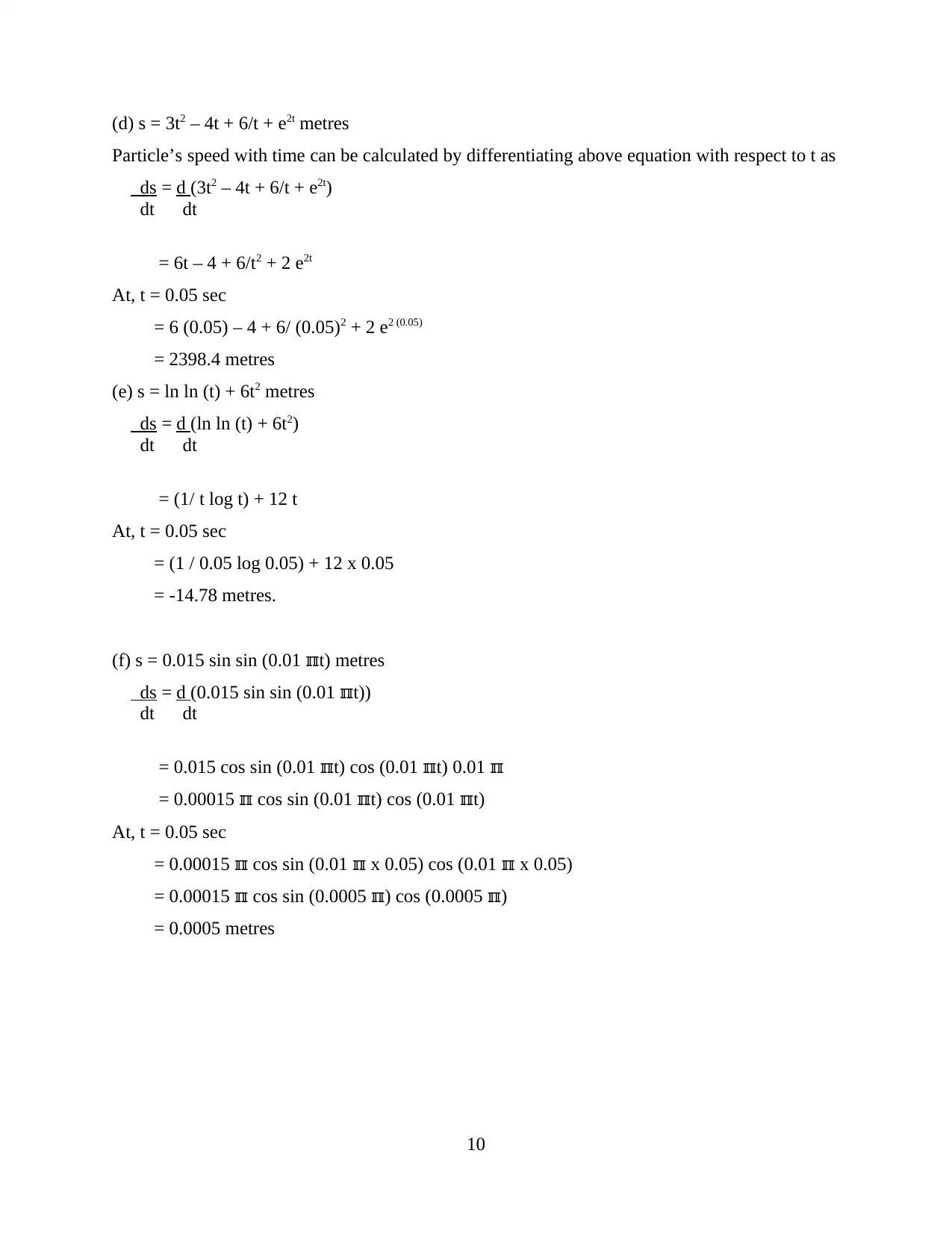
(d) s = 3t2 – 4t + 6/t + e2t metres
Particle’s speed with time can be calculated by differentiating above equation with respect to t as
ds = d (3t2 – 4t + 6/t + e2t)
dt dt
= 6t – 4 + 6/t2 + 2 e2t
At, t = 0.05 sec
= 6 (0.05) – 4 + 6/ (0.05)2 + 2 e2 (0.05)
= 2398.4 metres
(e) s = ln ln (t) + 6t2 metres
ds = d (ln ln (t) + 6t2)
dt dt
= (1/ t log t) + 12 t
At, t = 0.05 sec
= (1 / 0.05 log 0.05) + 12 x 0.05
= -14.78 metres.
(f) s = 0.015 sin sin (0.01 t) metresℼ
ds = d (0.015 sin sin (0.01 t))ℼ
dt dt
= 0.015 cos sin (0.01 t) cos (0.01 t) 0.01ℼ ℼ ℼ
= 0.00015 cos sin (0.01 t) cos (0.01 t)ℼ ℼ ℼ
At, t = 0.05 sec
= 0.00015 cos sin (0.01 x 0.05) cos (0.01 x 0.05)ℼ ℼ ℼ
= 0.00015 cos sin (0.0005 ) cos (0.0005 )ℼ ℼ ℼ
= 0.0005 metres
10
Particle’s speed with time can be calculated by differentiating above equation with respect to t as
ds = d (3t2 – 4t + 6/t + e2t)
dt dt
= 6t – 4 + 6/t2 + 2 e2t
At, t = 0.05 sec
= 6 (0.05) – 4 + 6/ (0.05)2 + 2 e2 (0.05)
= 2398.4 metres
(e) s = ln ln (t) + 6t2 metres
ds = d (ln ln (t) + 6t2)
dt dt
= (1/ t log t) + 12 t
At, t = 0.05 sec
= (1 / 0.05 log 0.05) + 12 x 0.05
= -14.78 metres.
(f) s = 0.015 sin sin (0.01 t) metresℼ
ds = d (0.015 sin sin (0.01 t))ℼ
dt dt
= 0.015 cos sin (0.01 t) cos (0.01 t) 0.01ℼ ℼ ℼ
= 0.00015 cos sin (0.01 t) cos (0.01 t)ℼ ℼ ℼ
At, t = 0.05 sec
= 0.00015 cos sin (0.01 x 0.05) cos (0.01 x 0.05)ℼ ℼ ℼ
= 0.00015 cos sin (0.0005 ) cos (0.0005 )ℼ ℼ ℼ
= 0.0005 metres
10
⊘ This is a preview!⊘
Do you want full access?
Subscribe today to unlock all pages.

Trusted by 1+ million students worldwide
1 out of 16
Related Documents
Your All-in-One AI-Powered Toolkit for Academic Success.
+13062052269
info@desklib.com
Available 24*7 on WhatsApp / Email
![[object Object]](/_next/static/media/star-bottom.7253800d.svg)
Unlock your academic potential
Copyright © 2020–2025 A2Z Services. All Rights Reserved. Developed and managed by ZUCOL.





